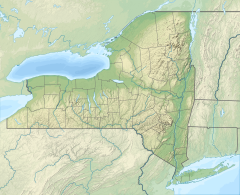
The Finger Lakes are a group of eleven long, narrow, roughly north–south lakes located directly south of Lake Ontario in an area called the Finger Lakes region in New York, in the United States. This region straddles the northern and transitional edge of the Northern Allegheny Plateau, known as the Finger Lakes Uplands and Gorges ecoregion, and the Ontario Lowlands ecoregion of the Great Lakes Lowlands.
Gorham is a town in Ontario County, New York, United States. The population was 4,130 at the 2020 census. The town is named after Nathaniel Gorham.
Hopewell is a town in Ontario County, New York, United States. The population was 3,931 at the 2020 census.
Seneca is a town in Ontario County, New York, United States. The population was 2,658 at the 2020 census. The town is named after a group of local natives.
South Bristol is a town in Ontario County, New York, United States. The population was 1,651 at the 2020 census. The name is derived from its separation from the Town of Bristol.

Italy is a town located in Yates County, New York, United States. As of the 2010 census, the town had a total population of 1,141. The town takes its name from the country of Italy.

Canandaigua Lake is the fourth largest of the Finger Lakes in the U.S. state of New York. The City of Canandaigua is located at the northern end of the lake and the village of Naples is several miles south of the southern end. It is the westernmost of the major Finger Lakes.

The Phelps and Gorham Purchase was the forced sale, in 1788, of a portion of a large tract of land in western New York State owned by the Seneca nation of the Iroquois Confederacy to a syndicate of land developers led by Oliver Phelps and Nathaniel Gorham. The larger tract of land is generally known as the "Genesee tract" and roughly encompasses all that portion of New York State west of Seneca Lake, consisting of about 6,000,000 acres (24,000 km2).

Oliver Phelps was an American politician. He was early in life a tavern keeper in Granville, Massachusetts. During the Revolution he was Deputy Commissary of the Continental Army and served until the end of the war. After the war ended, he was appointed a judge, was elected to the U.S. House of Representatives, and became a land speculator in western New York state. A depressed real estate market forced him to sell most of his holdings.

New York State Route 5 (NY 5) is a state highway that extends for 370.80 miles (596.74 km) across the state of New York in the United States. It begins at the Pennsylvania state line in the Chautauqua County town of Ripley and passes through Buffalo, Syracuse, Utica, Schenectady, and several other smaller cities and communities on its way to downtown Albany in Albany County, where it terminates at U.S. Route 9 (US 9), here routed along the service roads for Interstate 787 (I-787). Prior to the construction of the New York State Thruway, it was one of two main east–west highways traversing upstate New York, the other being US 20. West of New York, the road continues as Pennsylvania Route 5 (PA 5) to Erie.
Victor is an incorporated town in Ontario County, New York, United States. The population was 15,969 at the time of the 2020 census. The town is named after Claudius Victor Boughton, an American hero of the War of 1812.

The Buffalo River drains a 447-square-mile (1,160 km2) watershed in Western New York state, emptying into the eastern end of Lake Erie at the City of Buffalo. The river has three tributaries: Cayuga Creek, Buffalo Creek, and Cazenovia Creek.

The Seneca River flows 61.6 miles (99.1 km) through the Finger Lakes region of Upstate New York in the United States. The main tributary of the Oswego River – the second-largest river flowing into Lake Ontario – the Seneca drains 3,468 square miles (8,980 km2) in parts of fourteen New York counties. The Seneca flows generally east, and is wide and deep with a gentle gradient. Much of the river has been channelized to form part of the Erie Canal.
The Elmira and Lake Ontario Railroad was a subsidiary of the Northern Central Railway and later the Pennsylvania Railroad, formed to give the Northern Central an outlet for coal traffic on Lake Ontario.

New York State Route 488 (NY 488) is a state highway entirely in Ontario County, New York, in the United States. It extends for 9.53 miles (15.34 km) from an intersection with NY 21 in the town of Hopewell, near the city of Canandaigua, to a junction with NY 96 midway between the villages of Phelps and Clifton Springs. NY 488 also passes through the hamlet of Orleans, located within the town of Phelps. Although NY 488 is signed as a north–south highway, most of the route follows an east–west alignment. NY 488 was originally designated as part of NY 88 in the 1930 renumbering of state highways in New York. NY 88 was truncated to the village of Phelps in August 1972, at which time its former routing between NY 21 and NY 96 was renumbered to NY 488, eliminating an overlap with NY 96.

New York State Route 245 (NY 245) is a state highway in the Finger Lakes region of New York in the United States. The southern terminus of the route is at NY 21 in Naples. The northern terminus is at NY 5, U.S. Route 20 and NY 14A west of Geneva. From Geneva to Naples, NY 245 traverses the land from the north end of Seneca Lake to the south end of Canandaigua Lake in roughly a northeast to southwest direction.

New York State Route 364 (NY 364) is a state highway located in the Finger Lakes region of New York in the United States. It extends for 24.59 miles (39.57 km) from an intersection with NY 14A in Penn Yan to a junction with the concurrent routes of U.S. Route 20 (US 20) and NY 5 just east of the Canandaigua city limits. NY 364 follows a predominantly east–west alignment from Penn Yan to Middlesex and a north–south routing from Middlesex to Canandaigua, resulting in an L-shaped alignment. As a result, the route is posted as north–south north of Middlesex and east–west east of the hamlet. In the Canandaigua area, the road serves as a connector between US 20 and NY 5, Finger Lakes Community College, and the eastern shore of Canandaigua Lake.

Little Seneca Creek is an 14.0-mile-long (22.5 km) stream in Montgomery County, Maryland, roughly 18 miles (29 km) northwest of Washington, D.C.

Torrey Farms is a large family farm located in Elba, New York, with a satellite property located in Potter, New York. It is one of the largest vegetable-crop farm operations in New York. Together its two lots total some 10,000 acres, composed primarily of muckland, in the instance drained swampland.

The Canandaigua Outlet is a main tributary which feeds the Erie Canal and Clyde River in Wayne County, New York, United States. It begins at Canandaigua Lake in nearby Ontario County and flows approximately 34 miles (55 km) north before emptying into the Erie Canal in the hamlet of Lyons. A number of tributaries feed the Canandaigua Outlet along its route. It is the primary outflow for Canandaigua Lake.















